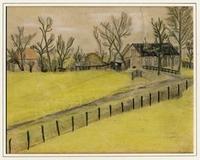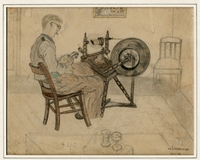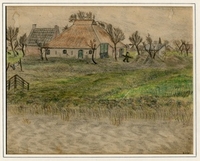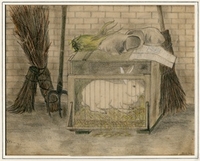Overview
- Brief Narrative
- Colored pencil drawing of the interior of a cow barn on a Dutch family’s farm near Genum (Ginnum), Netherlands, created by Abraham Rijksman while in hiding on January 20, 1944. Abraham and his family lived in Amsterdam when German forces occupied the Netherlands in May 1940. His family members were all arrested and deported between October 1942 and May 1943. Abraham was arrested in August 1943, and escaped twice from transport trains to Westerbork transit camp. The second time, he escaped with a pregnant woman, whose friend gave Abraham money to travel north to Friesland. In October, Abraham was forced to flee his first placement when German authorities searched the house. While hiding in nearby fields, Abraham found Jozeph (Joe) de Haan, who had also been forced out of hiding. A local farmer, Klaas Dreijer, offered them refuge in a barn near De Houwen, and later moved them to a hiding place near Holwerd. After two weeks, they were moved again. This time, they met the Rosier family, who helped hide them. Not long after, Klaas moved Abraham to a different Folkertsma family in Genum, though he sometimes visited Joe and the Rosiers. In May 1944, German authorities caught Abraham and transported him to Westerbork. He was then deported to Auschwitz-Birkenau killing center in German-occupied Poland and selected for slave labor. In mid-January 1945, Abraham was transferred to multiple camps in Germany, including Gross-Rosen, Buchenwald, and one of the Wüste complex subcamps of Natzweiler concentration camp. In mid-April, Abraham was transferred to the München-Allach subcamp of Dachau concentration camp, which was liberated in late April. He returned to the Netherlands and found his sister, Roza, the only other member of his family to survive.
- Date
-
creation:
1944 January 20
- Geography
-
depiction:
Friesland (Netherlands)
creation: Friesland (Netherlands)
- Credit Line
- United States Holocaust Memorial Museum Collection, Gift of Kitty Piller de Wolff
- Markings
- front, within image, bottom right, handwritten, pencil : 20 - 1 - 44 [January 20, 1944]
- Contributor
-
Artist:
Abraham Rijksman
Subject: Abraham Rijksman
- Biography
-
Abraham (or Albert) Rijksman (1918-2001) was born in Amsterdam, Netherlands, to Jewish Orthodox parents, Emanuel (1882-1943) and Theresia (nee Waterman, 1886-1943) Rijksman. Abraham's older brother, Natan (1908-1945) was a baker, and was married to Marianne Engelander (1909-1942). He also had two sisters: Roza Vos (1916-?) and Henriëtte Á Catan (1910-1943). Abraham often went by the nickname Appie.
German forces invaded the neutral Low Countries (Belgium, Luxembourg, and the Netherlands) on May 10, 1940, and occupied the Netherlands by the end of the month. Jews were required to register with local police and declare their assets. In February 1941, German authorities began segregating Jews from the general population, and imprisoned thousands in forced labor camps. Abraham’s brother and sister-in-law, Natan and Marianne, were arrested in 1942, and sent to Westerbork transit camp. On October 26, they were deported to Auschwitz concentration camp in German-occupied Poland, and Marianne was killed upon arrival. In April 1943, Abraham’s parents, Emanuel and Theresia, were arrested and held in the Hollandsche Schouwburg [Dutch Theater], which had been designated a Jewish theater by German authorities two years earlier. This allowed the authorities to requisition the theater and utilize it as an assembly point and detention center for Jews prior to their transport to Westerbork. After being sent to Westerbork, Emanuel and Theresia were deported on April 27 to Sobibor killing center in German-occupied Poland, and were killed upon arrival. Henriëtte was arrested on May 8, 1943, and held in the theater. Henriëtte was deported to Auschwitz and killed on October 22, 1943.
Abraham was arrested in August 1943, and held at the Hollandsche Schouwberg. He was sent to Westerbork transit camp, but escaped from the train before arriving. Not long after, he was recaptured and placed on a second train to Westerbork. He escaped again, this time with an unknown pregnant woman. The woman had a friend named Jacobovsky, who was either a Jewish double agent in the German Gestapo or an alleged collaborator. As a gesture of gratitude, Jacobovsky paid Abraham enough to make his way to Friesland, a northern province. In Friesland, Abraham was hidden by many different people in the region around Birdaard (Burdaard). At first, he hid with the Folkertsma family in Genum (Ginnum). The leader of underground movement, who had been in charge of Jewish placements in Friesland, had informed the Germans where to find 15 Jews hiding near Genum. The man was killed by his own people for being a traitor. In October 1943, German police arrived in the village of Genum to find and round up the Jews in hiding, including Abraham. The police burst into the house where Abraham was hiding, but he managed to escape and make his way out into the fields. Several hours later, he met up with another Jewish man hiding in the fields, Jozeph (Joe) de Haan. Joe had been hiding with the Vermeulen family on their isolated farm in Utsigh, where two nearby farmhands warned him early that morning that the Germans were coming. Joe managed to escape by crawling over a canal on a plank to reach the fields. Later, a farmer named Klaas Dreijer approached them and offered to help. Unlike most farmers in the area, he spoke Dutch and not just Frisian. Klaas gave them directions to a remote barn near De Houwen that was only used by locals to shelter herds during rough weather. Klaas was a resistance worker in the area, and he provided enough supplies for them to stay six or seven weeks. During their stay, the small children of local farmers would bring them food, sometimes far more than they could eat.
After four to six weeks, Klaas decided to move them because all the villagers were aware of them hiding there. He arranged another hiding place in the village of Holwerd, where a farmer had prepared a place in his old hay barn. To access the hiding place, Abraham and Joe would climb up the inside of the chimney, using protruding stones to get to the hayloft. After about two weeks, Klaas returned to move both Abraham and Joe again, this time to Heskampen to meet Jan and Martje Rosier, local farmers who helped hide them beginning in early December 1943. Around this time, Joe and Abraham split-up because Klaas took Abraham back to Genum where he hid with a different branch of the Folkertsma family. Once he left, Abraham was able to return and visit with Joe and the Rosiers several times. In May 1944, German authorities returned to the village to search for hidden Jews. They found and arrested Abraham, and transported him to Westerbork transit camp.
On May 19, 1944, Abraham was deported to Auschwitz-Birkenau killing center in German-occupied Poland. He was assigned prisoner number A-2757 under the name, Albert Ryksman, and selected for slave labor in a quarry. As Soviet forces approached the camp in mid-January 1945, it was evacuated and prisoners were deported to other camps in Germany. By February 10, Abraham was in Gross-Rosen concentration camp and then transferred to Buchenwald concentration camp, where he was assigned prisoner number 124825. Between March 5 and 9, Abraham was transported to one of the Wüste complex of subcamps in the Natzweiler concentration camp system. The main Natzweiler camp located in German-occupied France had been abandoned in September 1944, but its subcamps continued to operate. The Wüste subcamps were part of Unternehmen Wüste [Operation Desert], which was a German fuel project to extract oil from Württemberg shale in the Zollernalb district of Germany. Abraham was likely taken to the Bisingen subcamp, but could have also been at Erzingen or Dautmergen subcamps. As the Wüste camps were all being evacuated in mid-April, Abraham was transferred to the München-Allach subcamp of Dachau concentration camp on April 14, and assigned prisoner number 157735. The Dachau subcamps were liberated on April 29, 1945, by the United States Army.
Following liberation, Abraham walked and cycled to Weilheim, Germany, because he had heard that there were buses there taking Dutch refugees back to the Netherlands. He arrived in Oudenbosch and found his sister Roza, who had survived four concentration camps. He later learned that after his brother Natan arrived at Auschwitz in 1942, he was selected for slave labor, and transferred to four concentration camps in Germany over several years. He was likely killed during an air raid on April 25 at Mühldorf, a subcamp of Dachau. Jozeph de Haan survived in hiding at the Rosier farm, until the end of the war. Abraham and Roza both returned to Amsterdam. Roza remarried and had a daughter. Abraham married his first wife, Fannie (?-1982) in 1946. Following her death, Abraham married his second wife, Kitty Piller de Wolff. After the war ended, Joe and Abraham remained friends. In 2011, Jan and Martje Rosier were honored as Righteous Among the Nations by Yad Vashem.
Physical Details
- Language
- English
- Classification
-
Art
- Category
-
Drawings
- Object Type
-
Colored pencil drawing (lcsh)
- Genre/Form
- Drawings.
- Physical Description
- Matted, colored pencil drawing on paper depicting the interior of a freestall barn. Along the left side is a row of eight cows, facing the wall, and lying in pairs in four wood-framed stalls, except for the last cow, which is standing. The stalls are bedded with yellow straw, and bounded by a trench in the gray floor, into which the cows have defecated. At the far end of the trench, near the wooden door, is a long-handled, square shovel. To the right of the trench is a clean-swept floor, and a brick wall lined with a milk can and pail, a pitchfork, broom, bucket, water pump, a cat sitting on a bench, and a low shelf. A blue piece of clothing and two chains with hooked ends, hang above the tools. The date is penciled in the lower right corner. The paper is mounted to a tempered hardboard backing and adhered to a cream-colored, French window mat that has a thin-lined border around the window, drawn in pencil. There is a partial, English, black ink text stamp on the back of the hardboard.
- Dimensions
- pictorial area: Height: 7.375 inches (18.733 cm) | Width: 9.500 inches (24.13 cm)
overall: Height: 11.750 inches (29.845 cm) | Width: 13.375 inches (33.973 cm) | Depth: 0.250 inches (0.635 cm) - Materials
- overall : paper, colored pencil, graphite, tempered hardboard, mat board, adhesive, ink
- Inscription
- back, bottom edge, stamped, black ink : MADE IN
Rights & Restrictions
- Conditions on Access
- No restrictions on access
- Conditions on Use
- No restrictions on use
Keywords & Subjects
- Topical Term
- Concentration camp inmates--Biography. Deportees--Netherlands--Biography. Holocaust, Jewish (1939-1945)--Netherlands--Personal narratives. Jewish families--Netherlands--Amsterdam--Biography. Jews--Persecution--Netherlands--Biography. Righteous Gentiles in the Holocaust--Netherlands--Biography. Hiding places.
Administrative Notes
- Legal Status
- Permanent Collection
- Provenance
- The drawing was donated to the United States Holocaust Memorial Museum in 2012 by Kitty Piller de Wolff, the wife of Abraham Rijksman.
- Funding Note
- The cataloging of this artifact has been supported by a grant from the Conference on Jewish Material Claims Against Germany.
- Record last modified:
- 2023-08-28 07:55:58
- This page:
- https://collections.ushmm.org/search/catalog/irn47224
Download & Licensing
In-Person Research
- By Appointment
- Request 21 Days in Advance of Visit
- Plan a Research Visit
- Request to See This Object
Contact Us
Also in Abraham Rijksman collection
The collection consists of five drawings relating to the experiences of Abraham Rijksman while living in hiding in the Netherlands during the Holocaust.
Date: 1944 January

Drawing of a yellow field done in hiding by a Dutch Jewish man
Object
Colored pencil drawing of a yellow field beside a Dutch family’s farmhouse near Genum (Ginnum), Netherlands, created by Abraham Rijksman while in hiding on January 10, 1944. Abraham and his family lived in Amsterdam when German forces occupied the Netherlands in May 1940. His family members were all arrested and deported between October 1942 and May 1943. Abraham was arrested in August 1943, and escaped twice from transport trains to Westerbork transit camp. The second time, he escaped with a pregnant woman, whose friend gave Abraham money to travel north to Friesland. In October, Abraham was forced to flee his first placement when German authorities searched the house. While hiding in nearby fields, Abraham found Jozeph (Joe) de Haan, who had also been forced out of hiding. A local farmer, Klaas Dreijer, offered them refuge in a barn near De Houwen, and later moved them to a hiding place near Holwerd. After two weeks, they were moved again. This time, they met the Rosier family, who helped hide them. Not long after, Klaas moved Abraham to a different Folkertsma family in Genum, though he sometimes visited Joe and the Rosiers. In May 1944, German authorities caught Abraham and transported him to Westerbork. He was then deported to Auschwitz-Birkenau killing center in German-occupied Poland and selected for slave labor. In mid-January 1945, Abraham was transferred to multiple camps in Germany, including Gross-Rosen, Buchenwald, and one of the Wüste complex subcamps of Natzweiler concentration camp. In mid-April, Abraham was transferred to the München-Allach subcamp of Dachau concentration camp, which was liberated in late April. He returned to the Netherlands and found his sister, Roza, the only other member of his family to survive.

Drawing of a man at a spinning wheel done in hiding by a Dutch Jewish man
Object
Colored pencil drawing of Mr. de Lintrekker working at a spinning wheel in a Dutch family’s farmhouse near Genum (Ginnum), Netherlands, created by Abraham Rijksman while in hiding on January 10, 1944. Abraham and his family lived in Amsterdam when German forces occupied the Netherlands in May 1940. His family members were all arrested and deported between October 1942 and May 1943. Abraham was arrested in August 1943, and escaped twice from transport trains to Westerbork transit camp. The second time, he escaped with a pregnant woman, whose friend gave Abraham money to travel north to Friesland. In October, Abraham was forced to flee his first placement when German authorities searched the house. While hiding in nearby fields, Abraham found Jozeph (Joe) de Haan, who had also been forced out of hiding. A local farmer, Klaas Dreijer, offered them refuge in a barn near De Houwen, and later moved them to a hiding place near Holwerd. After two weeks, they were moved again. This time, they met the Rosier family, who helped hide them. Not long after, Klaas moved Abraham to a different Folkertsma family in Genum, though he sometimes visited Joe and the Rosiers. In May 1944, German authorities caught Abraham and transported him to Westerbork. He was then deported to Auschwitz-Birkenau killing center in German-occupied Poland and selected for slave labor. In mid-January 1945, Abraham was transferred to multiple camps in Germany, including Gross-Rosen, Buchenwald, and one of the Wüste complex subcamps of Natzweiler concentration camp. In mid-April, Abraham was transferred to the München-Allach subcamp of Dachau concentration camp, which was liberated in late April. He returned to the Netherlands and found his sister, Roza, the only other member of his family to survive.

Drawing of farmhouse and trees done in hiding by a Dutch Jewish man
Object
Colored pencil drawing of a Dutch family’s farm near Genum (Ginnum), Netherlands, created by Abraham Rijksman while in hiding on January 6, 1944. Abraham and his family lived in Amsterdam when German forces occupied the Netherlands in May 1940. His family members were all arrested and deported between October 1942 and May 1943. Abraham was arrested in August 1943, and escaped twice from transport trains to Westerbork transit camp. The second time, he escaped with a pregnant woman, whose friend gave Abraham money to travel north to Friesland. In October, Abraham was forced to flee his first placement when German authorities searched the house. While hiding in nearby fields, Abraham found Jozeph (Joe) de Haan, who had also been forced out of hiding. A local farmer, Klaas Dreijer, offered them refuge in a barn near De Houwen, and later moved them to a hiding place near Holwerd. After two weeks, they were moved again. This time, they met the Rosier family, who helped hide them. Not long after, Klaas moved Abraham to a different Folkertsma family in Genum, though he sometimes visited Joe and the Rosiers. In May 1944, German authorities caught Abraham and transported him to Westerbork. He was then deported to Auschwitz-Birkenau killing center in German-occupied Poland and selected for slave labor. In mid-January 1945, Abraham was transferred to multiple camps in Germany, including Gross-Rosen, Buchenwald, and one of the Wüste complex subcamps of Natzweiler concentration camp. In mid-April, Abraham was transferred to the München-Allach subcamp of Dachau concentration camp, which was liberated in late April. He returned to the Netherlands and found his sister, Roza, the only other member of his family to survive.

Drawing of a large white rabbit done by a Dutch Jewish man in hiding
Object
Colored pencil drawing of a caged rabbit on a Dutch family’s farm near Genum (Ginnum), Netherlands, created by Abraham Rijksman while in hiding on January 12, 1944. Abraham and his family lived in Amsterdam when German forces occupied the Netherlands in May 1940. His family members were all arrested and deported between October 1942 and May 1943. Abraham was arrested in August 1943, and escaped twice from transport trains to Westerbork transit camp. The second time, he escaped with a pregnant woman, whose friend gave Abraham money to travel north to Friesland. In October, Abraham was forced to flee his first placement when German authorities searched the house. While hiding in nearby fields, Abraham found Jozeph (Joe) de Haan, who had also been forced out of hiding. A local farmer, Klaas Dreijer, offered them refuge in a barn near De Houwen, and later moved them to a hiding place near Holwerd. After two weeks, they were moved again. This time, they met the Rosier family, who helped hide them. Not long after, Klaas moved Abraham to a different Folkertsma family in Genum, though he sometimes visited Joe and the Rosiers. In May 1944, German authorities caught Abraham and transported him to Westerbork. He was then deported to Auschwitz-Birkenau killing center in German-occupied Poland and selected for slave labor. In mid-January 1945, Abraham was transferred to multiple camps in Germany, including Gross-Rosen, Buchenwald, and one of the Wüste complex subcamps of Natzweiler concentration camp. In mid-April, Abraham was transferred to the München-Allach subcamp of Dachau concentration camp, which was liberated in late April. He returned to the Netherlands and found his sister, Roza, the only other member of his family to survive.



